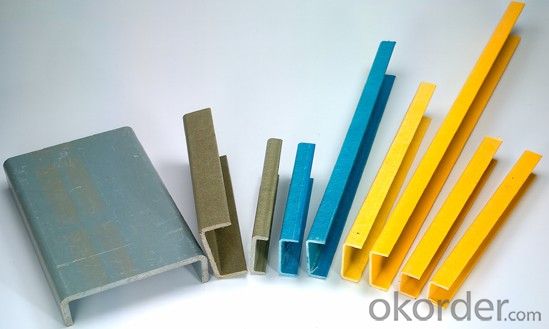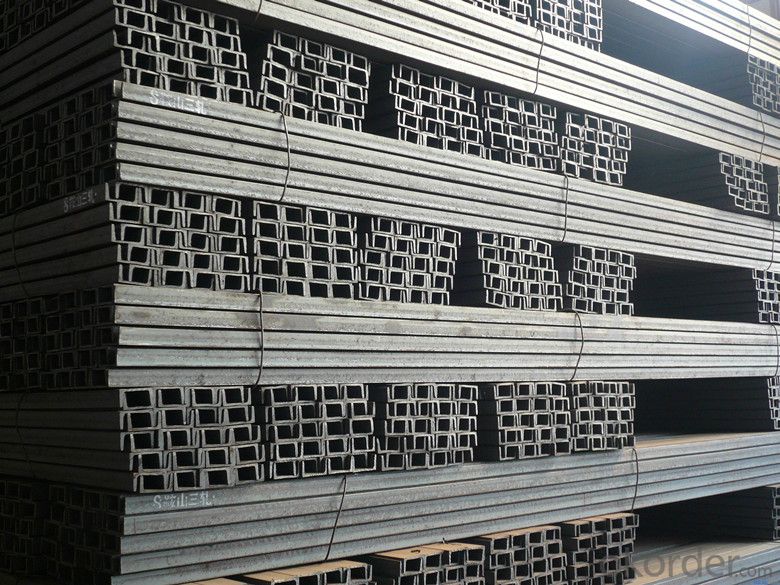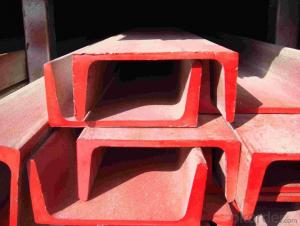Hot Rolled Galvanized Lip C Channel Steel Q195-Q235
- Loading Port:
- Tianjin
- Payment Terms:
- TT OR LC
- Min Order Qty:
- 4000 PCS
- Supply Capability:
- 38000 PCS/month
OKorder Service Pledge
Quality Product, Order Online Tracking, Timely Delivery
OKorder Financial Service
Credit Rating, Credit Services, Credit Purchasing
You Might Also Like
Hot Rolled Galvanized Lip C Channel Steel Q195-Q235 Details
| Standard: | AISI,ASTM,BS,DIN,GB,JIS | Dimensions: | 150*75*25*3.0mm | Grade: | carbon steel |
| Place of Origin: | China (Mainland) | Brand Name: | CNBM | Model Number: | 150mm*75mm*25mm*3.0mm |
| Shape: | C Channel | Application: | construction structure | Perforated Or Not: | Not Perforated |
| Grade:: | Q235,Q195,Q345,SS400,A36 | Length: | 3m, 6m, 9m, 12m, or as your request | Standard: | GB/ JIS |
| Size:: | 80*50mm--240*80mm | Surface:: | Perfect/ Galvanized/ oiled/ painted/ make holes | Technique: | Hot rolled/ cold rolled |
Packaging & Delivery
| Packaging Detail: | standard seaworthy packing or as your requirements. |
| Delivery Detail: | within 25- 35 days after signing the contract |
Hot Rolled Galvanized Lip C Channel Steel Q195-Q235 Specification
| Standard | AISI,ASTM,GB,JIS,DIN |
| Grade | Q195, Q215, Q235, ETC |
| Thickness | 1.0-4.0mm |
| Width | 30-350mm |
| Depth | 15-110mm |
| Lip Width | 10-30mm |
| Surface | Balce or Galvanized |
| usage | widely used in the purlin and wall beam of steel structure building, can be combined to make light weight roof truss, brecket, construction component, can be used in the production of beams and column, arm, in light industry machinery, etc. |
Hot Rolled Galvanized Lip C Channel Steel Q195-Q235 Pictures



- Q:Can steel channels be used in cold storage facilities?
- Yes, steel channels can be used in cold storage facilities. Steel is a strong and durable material that can withstand the low temperatures and provide structural support for the storage facility. It is commonly used in the construction of cold storage buildings due to its resistance to corrosion and ability to maintain stability in cold environments.
- Q:How do steel channels contribute to the overall stability of a bridge?
- Steel channels, which are often used in the construction of bridges, play a crucial role in ensuring the overall stability and structural integrity of the bridge. These channels, also known as structural steel sections, provide several key contributions to the bridge's stability. First and foremost, steel channels help distribute the load and weight of the bridge evenly across its span. By acting as horizontal beams, they effectively transfer the loads from the bridge deck to the supporting piers or abutments. This load distribution helps prevent any localized stress concentration, ensuring that the bridge can withstand the forces it encounters, such as the weight of vehicles, wind, or seismic events. Furthermore, steel channels also contribute to the torsional stability of the bridge. Torsional forces can occur due to various factors, including uneven loading, wind gusts, or the bridge's own weight distribution. By incorporating steel channels strategically in the bridge's design, these sections resist torsional forces, preventing any twisting or warping of the structure. This ensures that the bridge remains stable and maintains its intended shape over time. Additionally, steel channels enhance the overall stiffness and rigidity of the bridge. By connecting various structural elements, such as beams and columns, they provide an effective bracing system. This bracing prevents excessive deflection or bending of the bridge under loads, reducing any potential for deformation or failure. The added stiffness and rigidity provided by steel channels also help minimize the bridge's vibrations, ensuring a smoother and more comfortable experience for users. Moreover, steel channels offer versatility in their design and installation. They can be fabricated into various shapes and sizes, allowing engineers to tailor the bridge's structural components to the specific requirements of the project. This adaptability facilitates the optimization of the bridge's stability, enabling it to withstand different loads and environmental conditions. In conclusion, steel channels play a significant role in contributing to the overall stability of a bridge. They provide load distribution, torsional stability, stiffness, and rigidity, ensuring that the bridge can safely support the intended traffic loads and withstand external forces. Their versatility also allows engineers to create efficient and optimized bridge designs, enhancing the overall structural integrity and longevity of these essential infrastructural elements.
- Q:Channel 10, 6 meters long, two ends fixed, how much weight can the middle bear?
- For concentrated loads: M=1/4PL+1/8gL, =1/4 * 600P+1/8 * 0.1 * 600 * =39.4 * 1400=55160kg-cmP= (55160-1/8 x 0.1 x 600 x) x 4/600=337.73kg, that is, midspan can withstand the force of 337.73kg.
- Q:What are the specifications for steel channel coatings?
- The specific application and environment in which the steel channel will be used determine the varying specifications for its coatings. However, there are several commonly recommended coating specifications for steel channels. Firstly, the type of coating material is an important specification. Zinc-based galvanized coatings and epoxy coatings made from epoxy resins are commonly used for steel channels. These coatings protect against corrosion and enhance the channel's durability and longevity. Another crucial specification is the coating thickness, typically measured in microns. The required level of protection determines the coating thickness, which can vary. For instance, galvanized coatings usually have a thickness of approximately 20-40 microns, while epoxy coatings can range from 50-200 microns. Besides the coating material and thickness, other specifications may include adhesion properties, resistance to chemicals or abrasion, and the coating's color or appearance. These specifications are determined by the specific requirements of the application or industry in which the steel channel will be used. To ensure that the coating specifications for steel channels meet the desired level of protection and performance for the intended application, it is crucial to consult with a coating expert or follow industry standards and guidelines.
- Q:What are the different types of connections used for steel channels?
- Various types of connections are utilized for steel channels depending on the specific application and structural needs. Some commonly used connections are as follows: 1. Welded Connections: Welding is a prevalent method for joining steel channels. This process involves melting the channel ends and fusing them together using heat. Welded connections are known for their strength, durability, and excellent load-bearing capacity. 2. Bolted Connections: Bolted connections involve the use of bolts, nuts, and washers to connect steel channels. Holes are drilled in the channels, and bolts are inserted through these holes and tightened with nuts. Bolted connections offer easy installation, flexibility for disassembly, and can be adjusted or replaced if needed. 3. Riveted Connections: Riveting is an older method of connecting steel channels that involves using rivets. Rivets are inserted through pre-drilled holes in the channels and then hammered or pressed to secure them in place. Riveted connections provide strength and stability, although they are less common nowadays due to the labor-intensive installation process. 4. Composite Connections: Composite connections combine different connection methods to enhance overall strength and performance. For instance, a composite connection may utilize a combination of welding and bolting, providing the advantages of both methods. These connections are often preferred for high-load applications or when specific design requirements must be met. 5. Moment Connections: Moment connections are employed to transfer bending moments between steel channels. These connections are designed to withstand rotational forces and provide stability. Moment connections are typically created through welding and require meticulous design and engineering to ensure proper load distribution and structural integrity. It is important to consider factors such as load requirements, structural design, fabrication capabilities, and project specifications when selecting a connection type. Consulting a structural engineer or a professional with expertise in steel channel connections is highly recommended to ensure the appropriate connection type is chosen for a specific application.
- Q:How do steel channels perform under cyclic loading?
- Steel channels have a tendency to perform well when subjected to cyclic loading due to their inherent strength and durability. The unique shape of steel channels, which includes flanges and a web, offers structural stability and resistance against bending, shearing, and torsion forces. This makes them particularly suitable for applications where cyclic loading is present, such as bridges, industrial buildings, and machinery. When subjected to cyclic loading, steel channels demonstrate a high fatigue strength, meaning they can endure repeated loading and unloading cycles without significant deformation or failure. This is primarily due to the material properties of steel, which possess high elasticity and toughness. Additionally, steel channels possess a strong resistance to corrosion, which further enhances their performance under cyclic loading conditions. Furthermore, engineers have the ability to design steel channels with specific dimensions and cross-sections in order to optimize their performance under cyclic loading. By considering factors such as the expected magnitude and frequency of cyclic loading, as well as the material properties of the steel being used, engineers can calculate the necessary size and shape of the channel. This ensures that the steel channel can effectively distribute and withstand the cyclic loads, minimizing the risk of fatigue failure. However, it is important to acknowledge that the performance of steel channels under cyclic loading can be influenced by various factors, including the quality of the steel, the design and manufacturing process, and the installation and maintenance practices. Therefore, proper material selection, design considerations, and regular inspections are necessary to ensure the long-term performance and safety of steel channels under cyclic loading.
- Q:What is the maximum span for steel channels?
- The maximum span for steel channels depends on various factors such as the specific type and size of the channel, the load it will be subjected to, and the design requirements of the structure. Therefore, there is no one-size-fits-all answer to this question.
- Q:What are the different lengths available for steel channels?
- The lengths available for steel channels vary depending on the manufacturer and supplier. Common lengths for steel channels range from 20 feet to 40 feet, but custom lengths can also be ordered to suit specific project requirements.
- Q:Overhanging Scaffold; channel spacing
- The longitudinal horizontal rod shall be on the inside of the vertical pole, and its length shall not be less than 3 spans. Longitudinal butt joints should be staggered, two adjacent longitudinal joints should not be set in a synchronous or within the same span, not synchronous or different across the two adjacent joints staggered horizontal distance should not be less than 500mm, each jointcenter distance from the primary node is no larger than the vertical distance of 1/3. A bar two segment height should not exceed 2cm, the horizontal bar full Changping flatness can not exceed the total length of the scaffold of 1/300, and is no more than 10m.
- Q:How do you mark the types of steel such as channel, I-beam and so on in the document?
- Like the board, tube, and so on, right click on the Greek character mother with the keypad of the input method, and then choose.The thickness of the plate said.Phi means the diameter of the tube.H section steel, it is direct capital letters, H said in front of the good.A worker is a worker..Angle is digital symbols with small keyboard input method to select right angle of mathematical symbols.The slot is the keypad of the input method. Right click on the punctuation mark.By analogy.....
1. Manufacturer Overview |
|
|---|---|
| Location | |
| Year Established | |
| Annual Output Value | |
| Main Markets | |
| Company Certifications | |
2. Manufacturer Certificates |
|
|---|---|
| a) Certification Name | |
| Range | |
| Reference | |
| Validity Period | |
3. Manufacturer Capability |
|
|---|---|
| a)Trade Capacity | |
| Nearest Port | |
| Export Percentage | |
| No.of Employees in Trade Department | |
| Language Spoken: | |
| b)Factory Information | |
| Factory Size: | |
| No. of Production Lines | |
| Contract Manufacturing | |
| Product Price Range | |
Send your message to us
Hot Rolled Galvanized Lip C Channel Steel Q195-Q235
- Loading Port:
- Tianjin
- Payment Terms:
- TT OR LC
- Min Order Qty:
- 4000 PCS
- Supply Capability:
- 38000 PCS/month
OKorder Service Pledge
Quality Product, Order Online Tracking, Timely Delivery
OKorder Financial Service
Credit Rating, Credit Services, Credit Purchasing
Similar products
New products
Hot products
Related keywords



























